Dan Stevenson is a ranger pilot with the National Park Service. He is based in Kotzebue, Alaska, and monitors Kobuk Valley National Park, Noatak National Preserve, and Cape Krusenstern National Monument.
What do you do as a ranger pilot?
We [ranger pilots] wear a lot of hats. One thing I do is work with and just kind of supervise backcountry operations, keeping tabs on all backcountry operations that occur within all three parks, and that is roughly 9 million acres. Part of my job is to help with logistics and any issues that may occur in the backcountry of the park with our own staff, and then a big part of my job is to meet and greet the park visitors that are in the parks — Kobuk Valley National Park, Cape Krusenstern National Monument, and Noatak National Preserve. I try to get out as much as I can, [along with] other backcountry seasonal rangers we hire, or other permanent rangers we bring up from Anchorage or Fairbanks to help us out. We try to get out, and a lot of it is education, so we do a lot of the same think that interpreters and educators do in [the city of] Kotzebue, except we do that in the parks. We talk a lot about minimum-impact camping, or clean air or clean water, keeping a good clean campsite, how to travel safely in bear country, a lot of things you’ll hear in a visitor center in Kotzebue or around the country with the National Park Service. So we do a lot of proactive education and proactive enforcement too.
We have the authority to do law enforcement on federal lands, so that’s all the National Park Service land. A lot of that can include all our camping regulations in Alaska. A lot of that has to do with hunting or fishing or some type of consumptive harvest, especially in Northwest Alaska. If you think about it, we have almost year-round some type of consumptive harvest occurring in the park lands. Usually it’s fishing or caribou hunting, but we also have people berry-picking, we have people gathering firewood, trapping in the winter for furs — fox, wolverine, wolf — so it really occurs year-round. Along Cape Krusenstern, we also have marine mammal harvest, and a lot of that occurs in the ocean or on the ice floes near the coasts, and Fish and Wildlife Service has jurisdiction on the marine mammals, but once they come ashore, the local people will bring them ashore and they’re often butchering them on shore on Park Service land, so we get involved that way. A lot of that is just monitoring the walrus, seal, and polar bear harvest that occurs along the coastline of Cape Krusenstern. So I do that, and a lot of that is just talking with local hunters and local people from all the different villages.
Probably 80% of all our use on the park lands — and I’ve been here 18 years now, and I can say in the last 18 years it hasn’t changed much — about 80% of the use and our contacts out in the field are with local people from this region, as opposed to non-local people, and that could include Anchorage or Fairbanks, or Alabama or Montana or New York. That’s the way we call it, that’s non-local. Local folks are all the people who live and work and play here in Northwest Alaska. And most all those people are federally qualified subsistence users, and that’s a real important term in my world, so I’m always checking to make sure that the people who are hunting and trapping in Cape Krusenstern National Monument and Kobuk Valley National Park are federally qualified subsistence users. That’s a term that’s thrown around a lot, and it can be very confusing at times, but it’s a very important term, and that’s what ANILCA set up for those local people to be able to hunt and trap within the monument and the national park.
I get out there by boats, snow machines, and airplanes. They’re all just a tool to help us get out into the park lands. We also use canoes and packrafts and ATVs. We use them all to get out to the parklands around here, kind of the nature of Alaska. The airplane is just one more tool that we use to get out and do our job.
How long have you been flying?
I’ve been flying since I was 22. I was a starving college student in Montana and I always wanted to fly. I had no money for college since I used it up on flying lessons, which created some problems. I started earning my license when I was 22 and I’ve been flying ever since, so I guess about 30 years, and [many years] with the National Park Service. They have a real good program called a Pilot Training Program, and we’re always looking (my little recruitment pitch) for young pilots, men and women, who want to get into resource protection and being a pilot. The Park Service has a real good program that helps young pilots come up and get you experience, and your commercial rating, your instrument rating. They provide some good training which is required before you can fly for the government. That’s how I got in with the Park Service. I’d already worked for the Park Service as a backcountry ranger for about 15 seasons, and then I got into the ranger pilot training program about halfway through my career with the Park Service, so that was how I got in. Everyone gets in a little differently and starts at different times, but that’s how I got started with the ranger pilot position.
What advice would you have for young pilots who want to do what you do?
All the government is looking for, really, is you need your own private pilot certificate, so people need to get that on their own. That’s not a small step. That takes a fair amount of money and commitment, and that’s what the government likes to see, that you’re showing initiative and dedication to flying, before they invest a whole bunch of money. They want to see you have a of private pilot license, and usually 200 to 300 or 400 hours of solo time. If you have that as a bare minimum, you can start talking to aviation managers about the pilot training program. I’ll say too, it’s not just for law enforcement. We also have biologist pilots too. We call those “dual-function positions.” For me, it’s doing resource protection and [being] a pilot. For a biologist, they’re doing a lot of wildlife surveys, and [being] a pilot. And we are looking for more women in our program as well. We’re seeing more and more women pilots, which is outstanding, and we’re trying to recruit more women into the program. So there are definitely openings for more men and women in the program. You don’t have to be young; for resource protection you need to be 18 if you’re interested in being a law enforcement ranger. A lot of the pilots we see are usually in their thirties, because it’s taken them that long to get their pilot experience, so we have pilots of all ages that enter into the program, from their mid twenties to their forties.
What’s your favorite part of your job?
Oh, let’s see. I guess for me, it’s the resource. It’s the resource of Alaska [and that’s why] I’m here. I’ve never wanted to work anywhere else than Alaska. It’s the vastness, the incredible wilderness areas. Villages are few and far between. It’s hard to describe, but the vastness of Alaska has always intrigued me since I was in high school. And then obviously the people of Northwest Alaska are something I really enjoy too. The local people of this area have been very good to work with over the years in all types of situations, and I find this area has some of the friendliest people I’ve ever been around, as far as working and resource protection and issues out in the parklands. It’s hard to describe but it’s been a very rewarding place to work.
What are your least favorite aspects?
The least favorite? I’m sure everyone can relate to this very quickly, but it would be paperwork. Paperwork and bureaucracy. I’m a terrible computer person, so I struggle with the computers and software, and on top of that, we have horrible connectivity in Kotzebue, and it seems like more and more every year we are dependent upon software and computers to do our jobs, and I’m kind of an old ranger so that’s been hard for me to adjust to.
Where else have you worked as a ranger pilot?
Mostly in the Wrangells, in Wrangell-St. Elias, for about 15 seasons, 15 years. I was in Lake Clark for a couple years, and then the rest of it has been up here.
Where’s your favorite place to fly?
Oh, let’s see… I’d have to say there’s a little river called the Eli River up in the Noatak that’s pretty special. Just a real beautiful little river with conifers, hardwoods, alders.
What’s your favorite time of year to fly?
That’s a great question, because it’s right now! September is a great time to fly. The fall colors, the caribou are migrating, it can be a real nice time of year. September and even early October can be really nice.
What else would you like people to know about you, your job, or the Park Service?
The Park Service is always looking for people. We need people who want this kind of lifestyle, and this kind of remote lifestyle is not for everybody. So we need to find the good matches. There are a lot of people out there — rangers, interpreters, biologists — that do like this lifestyle, but it’s just trying to find them and connect them to the jobs can be difficult. It’s something we struggle with in the resource protection division, just like other divisions. It’s a very rewarding life if it’s that kind of lifestyle you want. It’s very much like an “emerging nation,” which has its own challenges that some people really thrive on. My wife and I really enjoy that, and that’s why we’re here. We call it a “Tilt-A-Whirl,” like everyday is in a tilt-a-whirl, because you never know what’s going to happen, and a lot of it has to do with logistics, a lot of things break, things don’t work, backup plans… So that whole tilt-a-whirl is kind of fun, but you have to be the right person to roll with that. I enjoy that too. One day to the next can be very different, and I find that really rewarding.



